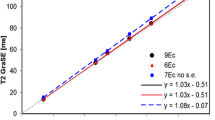Abstract
Myocardial tagging with magnetic resonance (MR) imaging offers unique possibilities for noninvasive left ventricular (LV) strain analysis. True three-dimensional strain analysis can be achieved with tags implemented in cardiac short axis and long axis images. Spin-echo (SE) techniques have been used for these studies. However, this approach is time-consuming: images at different phases of the cardiac cycle have to be obtained in successive measurements and hence the total number of measurements equals the number of time frames. Moreover, the images are often degraded by flow and motion artifacts. The purpose of this study was to optimize a faster and more robust MR tagging sequence for use on a clinical whole-body 1 T MR system with optimal persistence of the tags during the entire cardiac cycle. The tagging pulses were implemented in gradient-recalled-echo (GRE) sequences and compared to SE-based acquisitions. The effects of the use of flow-compensating gradients, the excitation angles, and the angles of the saturation pulses have been studied with MR signal simulations and in comparative measurements in volunteers. GRE acquisitions with flow-compensating gradients are robust techniques for myocardial tagging acquisitions. Use of optimized flip angles and saturation pulses can significantly improve delineation of the tag and can be used up to at least 700 ms after the R-wave. Therefore, LV tagging with GRE acquisitions using optimized MR parameters is a robust and promising technique.
Similar content being viewed by others
References
Edelman RR, Atkinson DJ, Silver MS, Loaiza FL, Warren WS (1988) FRODO pulse sequences: a new means of eliminating motion, flow and wraparound artifacts.Radiology 166 231–236.
Zerhouni EA, Parish DM, Rogers WJ, Yang A, Shapiro EP (1988) Human heart: tagging with MR imaging—a method for noninvasive assessment of myocardial motion.Radiology 169 59–63.
Moore CC, O'Dell WG, McVeight ER, Zerhouni EA (1992) Calculation of three-dimensional left ventricular strains from biplanar tagged MR images.J Magn Reson Imaging 2 165–175.
Rogers WJ, Shapiro EP, Weiss JL, Buchalter MB, Rademakers FE, Weisfeldt ML, Zerhouni EA (1991) Quantification and correction for left ventricular systolic long axis motion by magnetic resonance tissue tagging.Circulation 84 721–731.
Gao J-H, Holland SK, Gore JC (1988) Nuclear magnetic resonance signal from flowing nuclei in rapid imaging using gradient echoes.Med Phys 15 809–814.
Reeder SB, McVeigh ER (1994) Tag contrast in breath-hold cine cardiac MRI.Magn Reson Med 31 521–525.
Bottomley PA, Foster TH, Argersinger RE, Pfeifer LM (1987) A review of normal tissue hydrogen NMR relaxation times from 1–100 Mhz: dependence on tissue type, NMR frequency, temperature, species, excision, and age.Med Phys 14 1–37.
Axel L, Dougherty L (1989) MR Imaging of morion with spatial modulation of magnetization.Radiology 171 841–845.
Clark NR, Reichek N, Bergey P, Hoffman EA, Brownson D, Palmon L, Axel L (1991) Circumferential myocardial shortening in the normal human left ventricle: assessment by magnetic resonance imaging using spatial modulation of magnetization.Circulation 84 67–74.
Dong S-J, MacGregor JH, Crawley AP, McVeight E, Belenkie I, Smith ER, Tyberg JV, Beyar R (1994) Left ventricular wall thickness and regional systolic function in patients with hypertrophic cardiomyopathy: a three-dimensional tagged magnetic resonance imaging study.Circulation 90 1200–1207.
Pipe JG, Boes JL, Chenevert TL (1988) Method for measuring three-dimensional motion with tagged MR imaging.Radiology 181 591–595.
Maier SE, Fischer SE, McKinnon GC, Hess OM, Kraeyenbuehl H-P, Boesiger P (1992) Evaluation of left ventricular segmental wall motion in hypertrophic cardiomyopathy with myocardial tagging.Circulation 86 1919–1928.
Atkinson DJ, Edelman RR (1991) Cineangiography of the heart in a single breath hold with a segmented turboflash sequence.Radiology 178 357–360.
Author information
Authors and Affiliations
Rights and permissions
About this article
Cite this article
Bosmans, H., Bogaert, J., Rademakers, F. et al. Left ventricular radial tagging acquisition using gradient-recalled-echo techniques: sequence optimization. MAGMA 4, 123–133 (1996). https://doi.org/10.1007/BF01772519
Received:
Accepted:
Issue Date:
DOI: https://doi.org/10.1007/BF01772519




